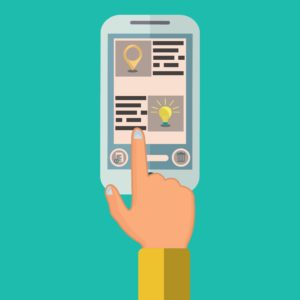Talk about a growth spurt. When Apple first introduced iBeacon in 2013, the location-based innovation was a mere novelty whose impact remained to be seen. Fast-forward to 2019, and the beacon technology market is now poised to exceed $25 billion over the next five years. Business owners worldwide are flocking to beacons, with retailers projected to account for more than half the market share. Let’s explore why beacon technology is amassing a Game of Thrones-level following.
![]()
What IS Beacon Technology, Anyway?
Despite its game-changing capabilities, beacon technology is born of a rather simple construct. Essentially, beacons are small, wireless transponders that use low-energy Bluetooth technology to facilitate communication between smart devices nearby. They seamlessly connect and transmit information to smart phones and mobile devices, allowing for easy, accurate, and efficient location-based searching and interaction.
In a nutshell, beacons employ proximity technology to recognize human presence nearby and then activate prescribed functions to deliver personalized (and private) experiences for users. For example, a shopper cruising the mall can walk past a store and—via the store’s beacon network—receive a notification in the form of a targeted ad or special offer on one of their favorite brands.
You can see howthis would be a mutually beneficial interaction for both consumer and marketer. It’s worth noting that marketers can’t take advantage of unsuspecting, window-shopping, smartphone users and flood them with unsolicited ads. There must be buy-in from the consumer as well. In other words, in order to make use of beacons, one must have:
- At least one beacon device
- A mobile app (third-party apps are fine)
- User Permission
Beacons Boost Business
Say that five times fast. It’s no secret that 21st-century consumers rely on their smartphones for just about everything, including brand and product research. Because mobile devices are frequently used to make purchasing decisions, it’s no wonder they’ve emerged as the nucleus around which businesses are developing their marketing and communication strategies.
Retailers are starting to leverage location-based beacon transmitters to enable real-time interaction with their customers. Through beacon technology, businesses can provide customers with exclusive deals, customized offers, and product information aligned with their preferences and purchase activity. The result? Beacons are proving to increase customer engagement and site/store revisits, generate impulse purchases, and facilitate an improved customer experience.
With e-commerce starting to dominate the U.S. retail landscape, businesses and merchandizers are capitalizing on the reach of beacon technology and its ability to provide a customized, content-fueled, digital shopping experience for consumers and clients. From an infrastructure standpoint, beacon technology thrives in highly-connected environments and regions. Thus, the growth and prevalence of smart cities worldwide is further driving the rise of beacon technology.
Connecting Beacons and Google Ads
Thinking of adding beacon technology to your marketing tool box? Smart move. Marketing teams and retailers are capturing valuable data and insights regarding their searchers’ offline activity by connecting beacon signals to their Google Ads account. In doing so (when serving Google search ads), they are potentially able to account for online users that visit their store or business.
Is there any bigger headache than attempting to track how your online marketing strategies, plans, and most importantly—budget, impact offline attribution? Beacon technology is proving to remove some of the guesswork and alleviate frustration. Through tracking the key interaction points of users who click on your digital ads, you can begin to study and analyze the effectiveness of your ads and measure their influence in terms of driving sales and customer visits to your store.
Let’s break down a standard interaction:
- A beacon user types in search terms “distressed leather messenger bag.”
- Voila! A Google search ad pops up for user viewing.
- Said user opens the ad, reviews the content and product info, and closes phone.
- The user then decides to enter your store and look at the bag in person, at which point their phone picks up a unique identifier from your store’s beacon.
- The beacon instantly links this phone to the one that recently accessed your digital search ad and records the interaction as store visit in your Google Ads account.
By tracking and compiling this user data, you’ll be better equipped to see what’s working and what’s not in terms of driving customer business and prompting store visits. Along that same vein, insights gained through beacon technology will in turn help you manage your budget and decide where to allocate marketing funds and where to scale back.

Beacons: Here to Stay?
Beacons are unquestionably generating buzz, but are they on track to become a permanent fixture in the technology market? Experts agree the long-term fate of beacons remains to be seen. Between their low-cost production and usage, along with Google’s plan to make the platform easier for developers to navigate and program, beacons appear to have a favorable future. Businesses view beacon technology as an effective compliment to traditional marketing strategies, while customers appreciate the efficient and personalized shopping experience it offers. However, it’s still a relatively new technology which means growing pains and roadblocks are to be expected.
Want to know more about implementing beacon technology into your 2019 business strategy? Contact ustoday and we’ll rap.
 Jason Turnquist
Jason Turnquist 